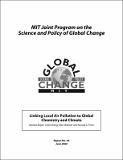| dc.contributor | Mayer, Monika. | en_US |
| dc.contributor | Wang, Chien. | en_US |
| dc.contributor | Webster, Mort David. | en_US |
| dc.contributor | Prinn, Ronald G. | en_US |
| dc.date.accessioned | 2003-10-24T14:56:21Z | |
| dc.date.available | 2003-10-24T14:56:21Z | |
| dc.date.issued | 2000-06 | en_US |
| dc.identifier.other | no. 63 | en_US |
| dc.identifier.uri | http://mit.edu/globalchange/www/abstracts.html#a63 | en_US |
| dc.identifier.uri | http://hdl.handle.net/1721.1/3582 | |
| dc.description | Abstract in HTML and technical report in PDF available on the Massachusetts Institute of Technology Joint Program on the Science and Policy of Global Change website (http://mit.edu/globalchange/www/) | en_US |
| dc.description | Includes bibliographical references (p. 26-29). | en_US |
| dc.description.abstract | We have incorporated a reduced-form urban air chemistry model in MIT's 2D-LO coupled chemistry-climate model. The computationally efficient reduced-form urban model is derived from the California Institute of Technology-Carnegie Institute of Technology (at Carnegie Mellon University) Urban Airshed Model by employing the probabilistic collocation method. To study the impact of urban air pollution on global chemistry and climate we carried out three simulations each including or excluding the reduced-form urban model for the time period from 1977 to 2100. In all three runs we use identical emissions, however in the two runs involving the reduced-form urban model the emissions assigned to urban areas are allocated in different ways depending on the scenario we assume for the future development of polluted urban areas. These two simulations are compared to the reference, which does not utilize the reduced-form urban model. We find that the incorporation of the urban air chemistry processes leads to lower global tropospheric NOx, ozone, and OH concentrations, but to a higher methane mole fraction than in the reference. The tropospheric mole fraction of CO is altered either up or down depending on the projections of urban emissions. The global mean surface temperature is effected very little by the implementation of the reduced-form urban model because predicted increases in CH4 are offset in part by decreases in O3 leading to only small changes in overall radiative forcing. | en_US |
| dc.format.extent | 36 p. | en_US |
| dc.format.extent | 7699005 bytes | |
| dc.format.mimetype | application/pdf | |
| dc.language.iso | eng | en_US |
| dc.publisher | MIT Joint Program on the Science and Policy of Global Change | en_US |
| dc.relation.ispartofseries | Report no. 63 | en_US |
| dc.subject.lcc | QC981.8.C5.M58 no.63 | en_US |
| dc.title | Linking local air pollution to global chemistry and climate | en_US |
